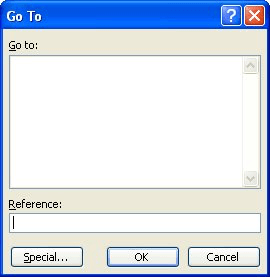Please Note: This article is written for users of the following Microsoft Excel versions: 97, 2000, 2002, and 2003. If you are using a later version (Excel 2007 or later), this tip may not work for you. For a version of this tip written specifically for later versions of Excel, click here: Selecting Noncontiguous Ranges with the Keyboard.
Written by Allen Wyatt (last updated May 10, 2022)
This tip applies to Excel 97, 2000, 2002, and 2003
Most people know that you can select a noncontiguous range of cells by using the mouse. All you need to do is click the first cell in the range and then hold down the Ctrl key as you click other cells in the range. (This is often referred to as creating a selection set of cells.)
Some folks don't like using the mouse that much. If you are in that camp, you may wonder if there is a way to select a noncontiguous range simply by using the keyboard. Fortunately there is, but very few folks know about it. Provided that you know the addresses of the cells you want in the range, follow these steps:

Figure 1. The Go To dialog box.
As an example, if you wanted your noncontiguous range to include cells A7, B2, F14 through G22, and T18, you would enter the following into the Reference box:
A7,B2,F14:G22,T18
Clicking OK then selects all these cells. In addition, the last cell that you entered is the "active cell" in the selected range.
ExcelTips is your source for cost-effective Microsoft Excel training. This tip (2401) applies to Microsoft Excel 97, 2000, 2002, and 2003. You can find a version of this tip for the ribbon interface of Excel (Excel 2007 and later) here: Selecting Noncontiguous Ranges with the Keyboard.

Create Custom Apps with VBA! Discover how to extend the capabilities of Office 365 applications with VBA programming. Written in clear terms and understandable language, the book includes systematic tutorials and contains both intermediate and advanced content for experienced VB developers. Designed to be comprehensive, the book addresses not just one Office application, but the entire Office suite. Check out Mastering VBA for Microsoft Office 365 today!
One of the important configuration files for Excel is known as the XLB file. You should periodically make backups of this ...
Discover MoreHave you ever recalculated a worksheet, only to notice that not everything calculated as it should? Here's a way you can ...
Discover MoreUsing the keyboard to switch between Excel spreadsheets.
Discover MoreFREE SERVICE: Get tips like this every week in ExcelTips, a free productivity newsletter. Enter your address and click "Subscribe."
There are currently no comments for this tip. (Be the first to leave your comment—just use the simple form above!)
Got a version of Excel that uses the menu interface (Excel 97, Excel 2000, Excel 2002, or Excel 2003)? This site is for you! If you use a later version of Excel, visit our ExcelTips site focusing on the ribbon interface.
FREE SERVICE: Get tips like this every week in ExcelTips, a free productivity newsletter. Enter your address and click "Subscribe."
Copyright © 2026 Sharon Parq Associates, Inc.
Comments